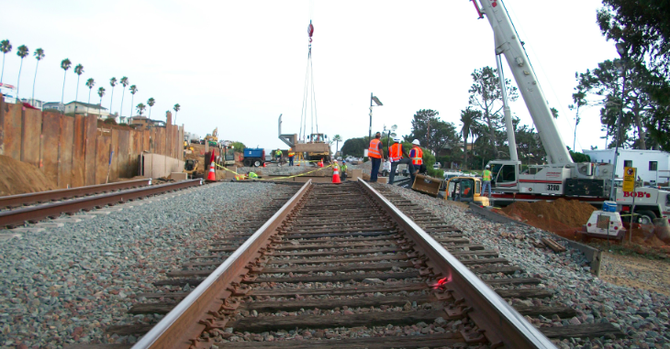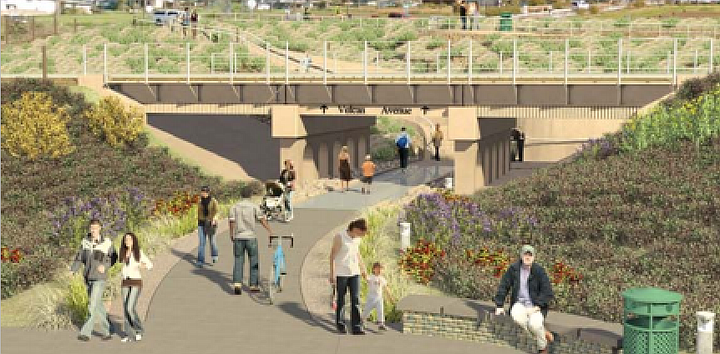 Facebook
Facebook
 X
X
 Instagram
Instagram
 TikTok
TikTok
 Youtube
Youtube

After the passing of the last northbound Coaster train from downtown on Friday night, September 7, Amtrak, Coaster, and freight-train service was suspended between Oceanside and San Diego.
Shortly after midnight, September 8, about 50 feet of train track in Encinitas, at Santa Fe Drive, were ripped up. Once removed, crews began installing heavy concrete and steel forms that will make a bridge allowing for a pedestrian undercrossing.
The 24 pre-constructed forms, weighing up to 20 tons each, needed to be dropped into place and welded together. Throughout the day Saturday, a 200-ton crane picked up the forms off of a continuous line of waiting semi-trucks parked on Coast Hwy. 101.
Rotating crews have worked the entire time the tracks have been closed. Although a project by the City of Encinitas and the owners of the tracks — North County Transit District — the construction is being coordinated by the San Diego Association of Governments.
By 5:00 p.m. Saturday, SANDAG's director of communications, Colleen Windsor, said they were on schedule and expected the tracks to be operational by Monday, September 10, at 5:00 a.m., in time for morning commuters on the Coaster.
Amtrak's Pacific Surfliner trains were still arriving at the Oceanside station from L.A. and returning north, on schedule. Passengers could reach the downtown San Diego station by buses provided by Amtrak. The Coaster is not providing alternative service during the outage.
The $5.9 million project is part of a $25.7 million plan to construct four pedestrian undercrossings in the city. The remaining three, at Hillcrest Drive in Leucadia, El Portal Street in Encinitas, and Montgomery Avenue in Cardiff, have yet to be funded.

Many in the community have called the undercrossings a huge waste of tax money (as reported in my Reader story of May 11, 2011). Citizens pointed out that residents have been safely crossing the coastal railroad tracks for almost 150 years. With over 50 trains a day, it is illegal to walk on railroad property or cross the tracks.
Community opposition subsided a little when engineering plans called for the track's bridge to form an open walkway under the tracks. A closed in, under-track tunnel, as used in other cities, reportedly attracts nighttime crime and sleeping transients.


After the passing of the last northbound Coaster train from downtown on Friday night, September 7, Amtrak, Coaster, and freight-train service was suspended between Oceanside and San Diego.
Shortly after midnight, September 8, about 50 feet of train track in Encinitas, at Santa Fe Drive, were ripped up. Once removed, crews began installing heavy concrete and steel forms that will make a bridge allowing for a pedestrian undercrossing.
The 24 pre-constructed forms, weighing up to 20 tons each, needed to be dropped into place and welded together. Throughout the day Saturday, a 200-ton crane picked up the forms off of a continuous line of waiting semi-trucks parked on Coast Hwy. 101.
Rotating crews have worked the entire time the tracks have been closed. Although a project by the City of Encinitas and the owners of the tracks — North County Transit District — the construction is being coordinated by the San Diego Association of Governments.
By 5:00 p.m. Saturday, SANDAG's director of communications, Colleen Windsor, said they were on schedule and expected the tracks to be operational by Monday, September 10, at 5:00 a.m., in time for morning commuters on the Coaster.
Amtrak's Pacific Surfliner trains were still arriving at the Oceanside station from L.A. and returning north, on schedule. Passengers could reach the downtown San Diego station by buses provided by Amtrak. The Coaster is not providing alternative service during the outage.
The $5.9 million project is part of a $25.7 million plan to construct four pedestrian undercrossings in the city. The remaining three, at Hillcrest Drive in Leucadia, El Portal Street in Encinitas, and Montgomery Avenue in Cardiff, have yet to be funded.

Many in the community have called the undercrossings a huge waste of tax money (as reported in my Reader story of May 11, 2011). Citizens pointed out that residents have been safely crossing the coastal railroad tracks for almost 150 years. With over 50 trains a day, it is illegal to walk on railroad property or cross the tracks.
Community opposition subsided a little when engineering plans called for the track's bridge to form an open walkway under the tracks. A closed in, under-track tunnel, as used in other cities, reportedly attracts nighttime crime and sleeping transients.